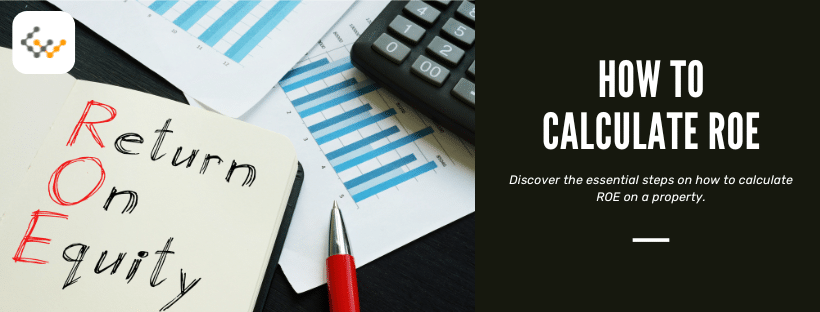ROE Formula: How to Calculate Return on Equity (ROE)

Return on equity (ROE) is a ratio used to measure the profitability of a real estate investment in comparison to shareholders’ stakes in the property. It shows how effectively an investment’s capital is being used to generate profits and thus is helpful when evaluating properties being considered or already in a portfolio.
Calculating ROE is a fairly straightforward process and something that every real estate investor should be familiar with.
What is Return on Equity?
Return on equity measures the financial performance of a property, by calculating the property’s profits in relation to what shareholders invested. It’s also referred to as return on net assets (ROA), because it shows what profits are being made in relation to what properties cost.
Essentially, ROE tells investors how effectively their capital is being utilized. The higher the ROE, the more efficient the management of equity capital.
(ROE can also be used to evaluate what returns a business investment provides.)
How to Calculate ROE on a Property
Calculating return on equity is a straightforward process, albeit one that requires knowing a couple of numbers: Net income and shareholders’ equity.
Net income is the profit that a property generates, taking into account all revenues and expenses. It includes rent payments, ancillary fees, maintenance, repairs, management costs, taxes, insurance, and any other income or expenses.
Shareholders’ equity refers to all equity that shareholders have in a property. This includes an initial cash investment, along with any equity that’s been gained through improvements, appreciation, or loan payments.
Importantly, return on equity is different from return on investment. ROI only considers the investments that shareholders have made, such as an initial cash investment and anything that’s been paid for improvements. ROE takes into account the increased equity that shareholders hopefully gain over time. Equity is dynamic, hopefully increasing, while investment is hopefully static.
Formula for Calculating ROE
The formula for calculating Return on Equity is:
Return on Equity = Net Income / Shareholders’ Equity x 100%
The ROE number is normally multiplied by 100%, and expressed as a percentage.
Example of Calculating ROE
For instance, consider a property purchased for $200,000. Assume the investor made a $50,000 down payment and took on a $150,000 mortgage, and they also paid another $20,000 for renovations. The annual net income from the property (after all expenses) is $10,000.
In this example, the shareholders’ equity is $70,000 ($50,000 down payment + $20,000 for renovations). The net income, as stated, is $10,000 annually. The return on equity would be 14.3% ($10,000 net income / $70,000 shareholders’ equity x 100%).
After a few years, trends and nearby development might appreciate the property’s value to $250,000. Because of this appreciation, equity has increased to $120,000. Net income might increase slightly to $12,000, but long-term leases could keep it from rising with demand. At this point, ROE would be 10% ($22,000 net income / $120,000 shareholders’ equity x 100%).
What’s a Good ROE in Real Estate?
What’s considered a “good” ROE can vary significantly by property type, market, and other details.
A property in New York City will likely have a much lower ROE than one in Upstate New York because NYC properties are worth so much more. Both could be profitable investments, though.
Real estate investors should generally look for an ROE of 2-5%. ROE will be much lower when property values are high, and it will usually decrease over time as equity increases. The above example would be a high-cash-flow property in an area where property values are extremely low, such as a rural area with a growing town.
Advantages of Using ROE
Return on equity is a standard and common metric used in commercial real estate, and for good reason. There are several advantages to using it:
- Performance Measurement: Provides a clear indication of how effectively an investment is being managed relative to the equity invested.
- Comparative Analysis: Enables investors to compare the financial performance of different and varied properties.
- Decision Making: Helps determine whether to continue holding a property, sell it, or buy additional properties based on the returns on equity capital.
Limitations of ROE
That said, every metric used has limitations. The limitations of return on equity include:
- Debt Impact: High debt levels can artificially inflate ROE, especially if there’s a low-interest loan or one with a large future balloon payment. ROE should be considered alongside a property’s debt-to-equity ratio.
- One-Dimensional: ROE does not account for risks or opportunities. It’s a lagging metric rather than a predictive one, although it can be used when making decisions. Perhaps most notably, it doesn’t take into account long-term appreciation.
- Property Specific: Variations in market conditions, property location, and management practices can lead to significant disparities in ROE. While it can be a useful way to compare varied properties, investors should understand that ROE expectations are sometimes different for different markets, locations, and property types. Returns outside of net income, namely appreciation, must also be considered.
ROE for Investing Decisions
ROE is one of the most important metrics when making investment decisions about real estate properties. Returns on what shareholders have help with decisions on potential and current properties and evaluating a manager’s performance.
Why Does it Matter to Understand ROE?
Understanding ROE helps investors gauge the effectiveness of their investment. It aids in strategic decision-making, from restructuring financing to optimizing operational management for better returns. Most importantly, it’s a way to evaluate how well equity is being used.
Wrapping Up
If you’re involved in commercial real estate, return on equity is something you should understand and use. Calculate it on properties, and you’ll be better informed of how your properties are doing in relation to what you have in them.

